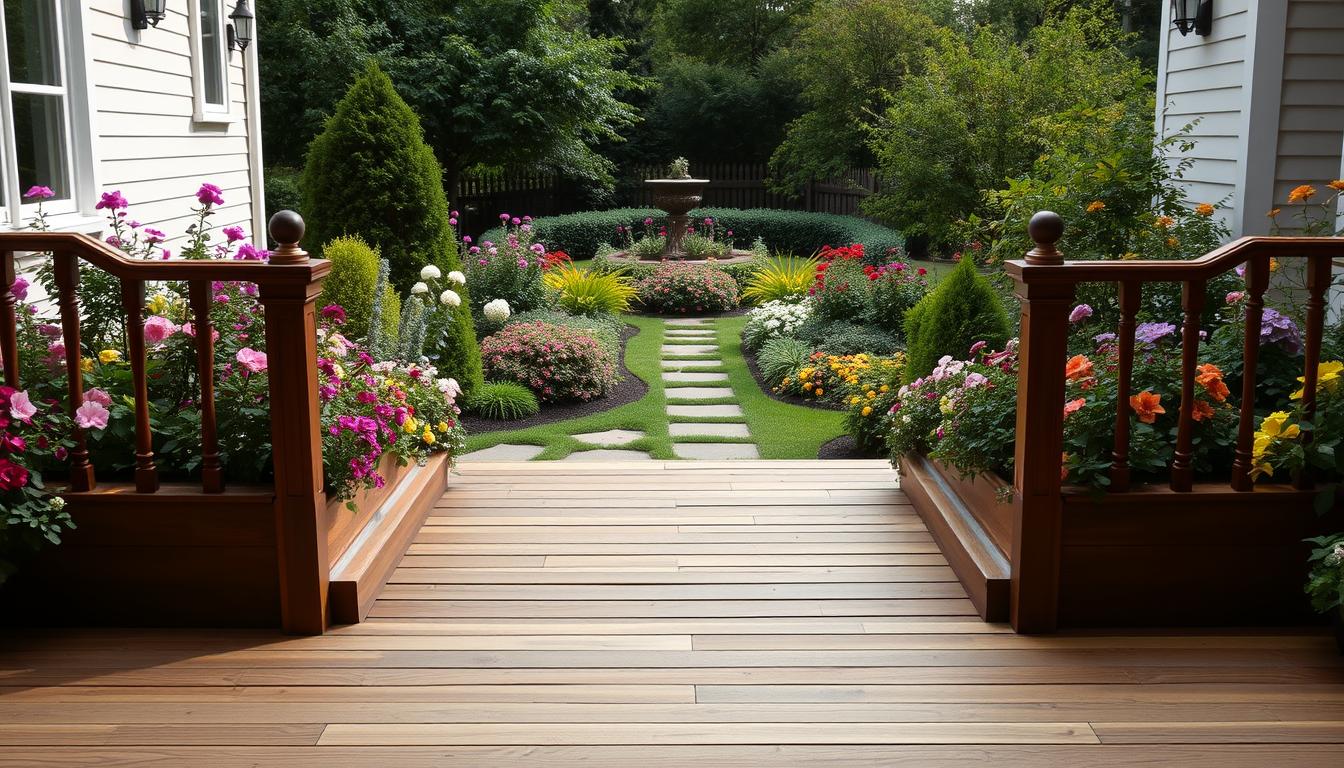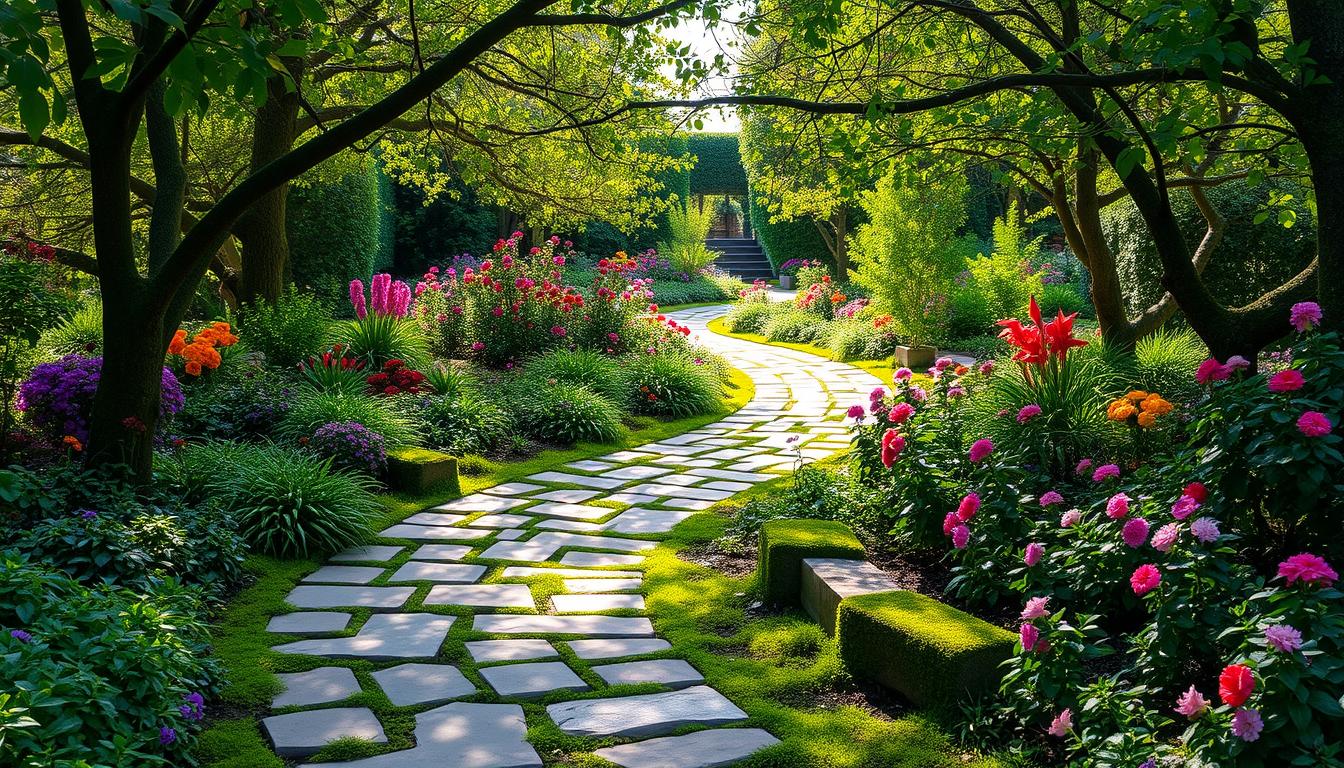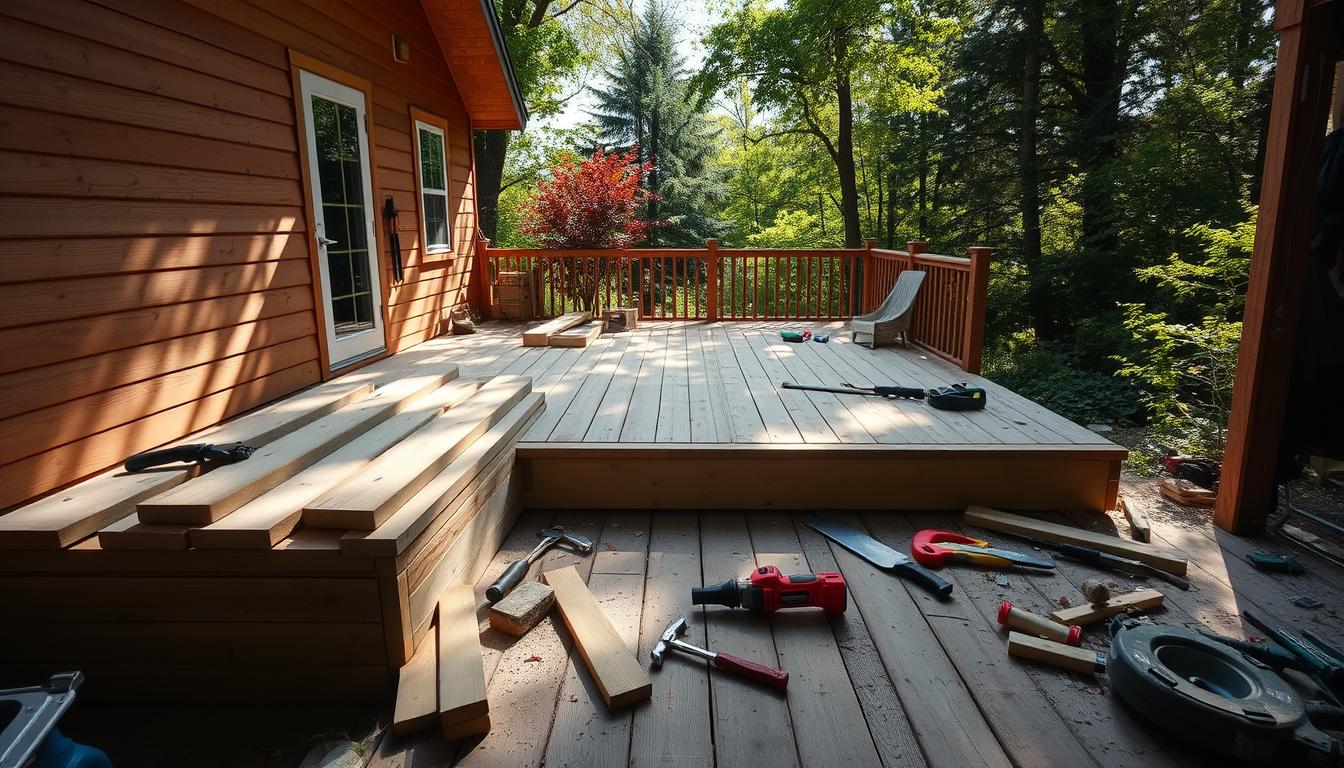Outdoor steps are vital for any home’s exterior, offering a safe path to the front door and boosting curb appeal. Ensuring these steps meet safety standards is crucial to avoid accidents and ensure a secure entrance. By focusing on safety, homeowners can enhance their property’s value and beauty.
Creating outdoor steps that adhere to safety standards demands meticulous planning and attention to detail. From evaluating the site to selecting materials, each step is crucial for a safe and attractive outdoor area. By prioritizing safety and incorporating attractive designs, homeowners can create steps that are both secure and enhance their home’s beauty.
Introduction to Outdoor Steps
Outdoor steps are a key feature of any home, offering a safe and accessible path to the front door. By focusing on safety standards, homeowners can create a secure and attractive entryway that boosts their property’s curb appeal.
Key Takeaways
- Outdoor steps must meet safety standards to prevent accidents and ensure a secure entry point.
- Building outdoor steps can significantly boost a property’s value and aesthetic appeal.
- Outdoor steps require careful planning and attention to detail to ensure safety and attractiveness.
- Prioritizing safety standards is crucial when building outdoor steps.
- Outdoor steps can enhance the overall beauty of a home when designed with visually appealing elements.
- Regular maintenance is necessary to ensure the longevity and safety of outdoor steps.
Why Outdoor Steps Matter for Your Home
Outdoor stairs and garden access are vital for a home’s exterior. They offer a safe, attractive path between different levels. A well-designed outdoor stairway boosts a home’s aesthetic appeal, making it more welcoming to visitors.
Research indicates that outdoor features, like stairs, significantly impact property value. A well-crafted outdoor space can raise a property’s value by up to 10%. This is due to their functional and aesthetic benefits, turning outdoor areas into beautiful living spaces.
Impact on Property Value
A well-designed outdoor stairway enhances safety and accessibility. It provides a safe path to different levels, reducing accident risks. Outdoor stairs can also be made accessible for those with disabilities, improving property navigation.
Safety and Accessibility Benefits
Outdoor stairs and garden access offer several benefits:
- Increased property value
- Improved safety and accessibility
- Enhanced curb appeal
- Creation of a beautiful and inviting outdoor living space
Curb Appeal Enhancement
In summary, outdoor stairs and garden access are key to a home’s exterior. They ensure safety, attractiveness, and functionality. Investing in well-designed outdoor stairs can elevate a home’s value, safety, and curb appeal. This creates a stunning outdoor living space.
| Benefits | Description |
|---|---|
| Increased Property Value | Up to 10% increase in property value |
| Improved Safety and Accessibility | Reduced risk of accidents and injuries |
| Enhanced Curb Appeal | Creation of a beautiful and inviting outdoor living space |
Planning Your Outdoor Steps Project
Building outdoor steps requires careful planning for a successful and safe outcome. This involves assessing your needs, budgeting, and selecting the right location. Effective step construction demands attention to terrain and slope management.
To begin, consider these steps:
- Assess your needs: Determine the purpose of your outdoor steps and the amount of traffic they will receive.
- Budgeting: Establish a budget for your project and consider the costs of materials, labor, and any necessary permits.
- Choosing a location: Select a location that is safe, functional, and visually appealing, taking into account the natural slope management of your yard.
By meticulously planning your outdoor steps project, you can ensure safety and functionality. It also enhances your home’s aesthetic. Remember to focus on step construction and slope management early to avoid future problems.
Essential Safety Standards for Outdoor Steps
Outdoor steps require strict adherence to safety standards. Homeowners must follow local building codes and safety regulations. This ensures that outdoor steps are safe for everyone. Key aspects include installing handrails and providing adequate lighting.
To ensure a safe outdoor step experience, it’s vital to follow these essential safety standards:
- Building code requirements: Compliance with local building codes is mandatory to ensure that outdoor steps are constructed with safety in mind.
- Recommended dimensions: Adhering to recommended dimensions for steps and landings helps prevent accidents and injuries.
- Handrail specifications: Properly installed handrails provide support and stability, reducing the risk of falls.
- Lighting requirements: Adequate lighting illuminates the steps, making it easier to navigate and reducing the risk of tripping or falling.
By adhering to these safety standards and prioritizing outdoor safety, homeowners can create a secure and enjoyable outdoor space. This is for themselves and their loved ones.
| Safety Standard | Description |
|---|---|
| Building Code Requirements | Compliance with local building codes |
| Recommended Dimensions | Adhering to recommended dimensions for steps and landings |
| Handrail Specifications | Properly installed handrails for support and stability |
| Lighting Requirements | Adequate lighting for illumination and safety |
Choosing the Right Materials
The selection of step materials greatly impacts the longevity, upkeep, and visual appeal of outdoor steps. Homeowners face a variety of choices, ranging from traditional wood to concrete and advanced composite materials.
Some of the most sought-after step materials include:
- Wood: A timeless favorite, wood brings a warm, natural ambiance to outdoor steps.
- Concrete: Known for its durability and minimal upkeep, concrete is a common choice for outdoor steps.
- Composite materials: A blend of different materials, composite steps offer a robust and easy-to-maintain option.
Each step material comes with its own set of advantages and disadvantages. The ideal choice hinges on the homeowner’s specific requirements and budget. By examining factors like durability, upkeep, and visual appeal, homeowners can make a well-informed decision. This ensures they select the most suitable step materials for their outdoor steps.
The selection of step materials ultimately rests on the homeowner’s personal preferences and needs. By carefully evaluating the benefits and drawbacks of each option, homeowners can create outdoor steps that are both beautiful and functional. These steps will not only enhance the home’s curb appeal but also its value.
| Material | Pros | Cons |
|---|---|---|
| Wood | Warm and natural appearance, can be stained or painted | Requires regular maintenance, can rot or decay |
| Concrete | Durable and low-maintenance, can be stamped or colored | Can be cold and uninviting, may crack over time |
| Composite materials | Durable and low-maintenance, resistant to rot and decay | Can be more expensive than other options, may not be as aesthetically pleasing |
Design Options for Attractive Outdoor Steps
Designing outdoor stairs offers a wide range of options, each with its own aesthetic and functional benefits. The right design can beautifully connect the house to the yard, enhancing garden access. Outdoor stairs can also complement the home’s architecture, ensuring safe and easy access to the garden or yard.
The design of outdoor steps significantly impacts a home’s exterior look and feel. Traditional styles, such as brick or stone, bring a classic elegance. Modern designs, featuring materials like metal or glass, offer a sleek, contemporary appearance. Natural stone options, such as bluestone or fieldstone, add sophistication and elegance to outdoor stairs.
Traditional Styles
Traditional outdoor stairs often use classic materials like brick, stone, or wood. These designs warm up the outdoor space, blending well with garden access. Popular traditional styles include:
- Brick outdoor stairs, matching the home’s brickwork
- Stone outdoor stairs, adding elegance and sophistication
- Wooden outdoor stairs, offering a warm, inviting feel
Modern Designs
Modern outdoor stairs use sleek materials like metal or glass. These designs offer a contemporary look, integrating well with garden access. Popular modern styles include:
- Metal outdoor stairs, adding an industrial chic
- Glass outdoor stairs, providing a sleek, modern appearance
- Concrete outdoor stairs, matching the home’s concrete work
Choosing the right design for your outdoor stairs can create a beautiful transition between the house and yard. It also ensures safe, easy access to the garden.
| Design Style | Materials | Benefits |
|---|---|---|
| Traditional | Brick, stone, wood | Classic look, warm and inviting |
| Modern | Metal, glass, concrete | Sleek and contemporary, easy to maintain |
| Natural Stone | Bluestone, fieldstone | Elegant and sophisticated, durable |
Step-by-Step Construction Process
Building outdoor steps requires a well-thought-out construction process. It involves site preparation, foundation work, step assembly, and finishing touches. Effective step construction demands meticulous attention and a deep understanding of the project’s needs.
Slope management is a critical aspect of outdoor step construction. It ensures the steps are stable and safe, even on uneven terrain. By integrating slope management, homeowners can create a functional and attractive outdoor space.
Site Preparation
Site preparation is essential before starting construction. It includes clearing debris, leveling the ground, and ensuring the soil is stable. A well-prepared site is the cornerstone of a successful construction project.
Foundation Work
A solid foundation is vital for outdoor steps. This involves excavating, laying the foundation material, and ensuring it’s level and secure. By focusing on foundation work, homeowners can establish a strong base for their outdoor steps.
Step Assembly
With the foundation in place, it’s time to assemble the steps. This involves cutting and fitting the step materials, ensuring they’re secure and level. Careful planning and execution allow homeowners to create steps that are both functional and visually appealing.
By adhering to a step-by-step construction process and using effective slope management techniques, homeowners can enhance their property’s value and beauty. Whether you’re a seasoned contractor or a DIY enthusiast, a well-planned construction process is key to achieving professional-looking results.
Managing Slopes and Drainage
Proper slope management is essential for outdoor steps’ safety and longevity. It requires evaluating the land’s slope and designing drainage systems to avoid erosion and accidents. To enhance outdoor safety, techniques like retaining walls or geogrids can stabilize the soil.
Key aspects of slope management and drainage include:
- Assessing the land’s slope for the best drainage solution
- Creating a drainage system that handles heavy rainfall and stormwater
- Using slope stabilization methods to prevent erosion and landslides
By focusing on slope management and outdoor safety, homeowners can create a safe outdoor space. This space can be enjoyed for many years.
| Slope Management Technique | Description |
|---|---|
| Retaining Walls | Structures designed to hold back soil and prevent erosion |
| Geogrids | Materials used to stabilize soil and prevent landslides |
| Drainage Systems | Networks of pipes and channels designed to manage stormwater runoff |
Maintenance Tips for Long-lasting Outdoor Steps
To keep outdoor steps safe and looking good, regular upkeep is key. It’s important to check the steps often for damage or wear. Fixing these problems quickly is vital. Also, picking durable step materials helps reduce the need for maintenance.
Outdoor safety is paramount, and regular care can prevent accidents. A well-kept staircase can handle different weather, lowering the chance of slips and falls. Adding outdoor safety features like non-slip coatings and sturdy handrails makes your outdoor area safer and more accessible.
Seasonal Care Guide
- Inspect the steps for damage or wear and tear
- Clean the steps regularly to prevent dirt and debris buildup
- Apply a protective coating to the steps to shield them from the elements
Repair Procedures
Outdoor steps often face issues like cracked or broken steps, loose handrails, and foundation damage. Having a repair plan is crucial. This might mean replacing broken steps, securing loose handrails, or strengthening the foundation.
Weather Protection Methods
Severe weather can harm outdoor steps, so protecting them is essential. You can use a waterproof sealant, install a canopy or awning, or choose step materials that resist weathering.
| Step Material | Maintenance Needs | Weather Resistance |
|---|---|---|
| Wood | High | Low |
| Concrete | Low | High |
| Stone | Medium | Medium |
Conclusion: Creating Safe and Beautiful Access to Your Home
Outdoor steps are more than a necessity; they are a key part of your home’s design and safety. By focusing on safety standards, ensuring proper step construction, and embracing the beauty of outdoor stairs, you can create a welcoming entrance. This enhances both the function and appeal of your home’s exterior.
This guide has given you the crucial information for building or renovating outdoor steps. You now understand the importance of building codes, material selection, and design. With this knowledge, you can transform your home’s exterior and boost its curb appeal.
Your outdoor steps are a reflection of your home’s style and your commitment to safety and beauty. By following the guidelines and recommendations in this guide, you can start your outdoor steps project with confidence. Enjoy the lasting benefits of your efforts for many years.




